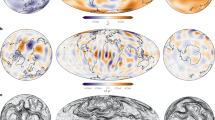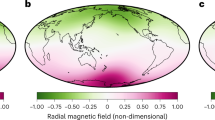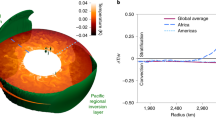Abstract
An estimate of the magnitude and geometry of the magnetic field within the Earth's core would be valuable for understanding the dynamics of the liquid outer core and for constraining numerical models of the geodynamo. The magnetic field down to the core–mantle boundary can be estimated from surface observations by assuming that the mantle is an insulator1, but such estimates cannot be further extrapolated into the conducting core itself. The magnetic field within the core has therefore remained largely unconstrained. Here we construct a simple picture of part of the magnetic field within the core by first showing that the fluid flow at the surface of the core is consistent with the presence of two large waves—‘torsional oscillations’ of the type that have been proposed to explain the temporal variation of the magnetic field at the core–mantle boundary. We then use the structure of these waves to calculate a one-dimensional map of the part of the magnetic field that points away from the rotation axis. These results may help distinguish between the different dynamic states proposed for outer-core flow2,3,4,5 and provide a test for recent numerical models of the geodynamo6,7,8,9.
This is a preview of subscription content, access via your institution
Access options
Subscribe to this journal
Receive 51 print issues and online access
$199.00 per year
only $3.90 per issue
Buy this article
- Purchase on Springer Link
- Instant access to full article PDF
Prices may be subject to local taxes which are calculated during checkout




Similar content being viewed by others
References
Gubbins, D. Geomagnetic field analysis—I. Stochastic inversion. Geophys. J. R. Astron. Soc. 73, 641–652 (1993).
Taylor, J. B. The magnetohydrodynamics of a rotating fluid and the Earth's dynamo problem. Proc. R. Soc. Lond. A 274, 274–283 (1963).
Braginsky, S. I. Nearly axisymmetric model of the hydromagnetic dynamo of the Earth I. Geomag. Aeron. 15, 122–128 (1975).
Roberts, R. H. From Taylor state to model-Z? Geophys. Astrophys. Fluid Dyn. 49, 143–160 (1989).
Jault, D. Model Z by computation and Taylor's condition. Geophys. Astrophys. Fluid Dyn. 79, 99–124 (1995).
Glatzmaier, G. A. & Roberts, P. H. Athree-dimensional convective dynamo solution with rotating and finitely conducting inner core and outer mantle. Phys. Earth Planet. Inter. 91, 63–75 (1995).
Glatzmaier, G. A. & Roberts, P. H. Athree-dimensional self-consistent computer simulation of a geomagnetic field reversal. Nature 377, 203–209 (1995).
Jones, C. A., Longbottom, A. W. & Hollerbach, R. Aself-consistent convection driven geodynamo model using a mean field approximation. Phys. Earth Planet. Inter. 92, 119–141 (1995).
Kuang, W. & Bloxham, J. An Earth-like numerical dynamo model. Nature(in the press).
Bloxham, J. & Jackson, A. Fluid flow near the surface of the of Earth's outer core. Rev. Geophys. 29, 97–120 (1991).
Hills, R. G. Convection in the Earth's mantle due to viscous shear at the core-mantle interface and due to large-scale buoyancy. Thesis, New Mexico State Univ.(1979).
LeMouël, J.-L. Outer core geostrophic flow and secular variation of Earth's magnetic field. Nature 311, 734–735 (1984).
Whaler, K. A. Does the whole of the Earth's core convect? Nature 287, 528–530 (1980).
Gubbins, D. Finding core motions from magnetic observations. Phil. Trans. R. Soc. Lond. A 306, 247–254 (1982).
Voorhies, C. V. & Backus, G. E. Steady flows at the top of the core from geomagnetic field models: The steady motions theorem. Geophys. Astrophys. Fluid Dyn. 32, 163–173 (1985).
Jault, D., Gire, C. & LeMouël, J.-L. Westward drift, core motions and exchanges of angular momentum between core and mantle. Nature 333, 353–356 (1968).
Jackson, A., Bloxham, J. & Gubbins, D. in Dynamics of Earth's Deep Interior and Earth Rotation(eds LeMouël, J.-L., Smylie, D. E. & Herring, T.) 97–107 (Geophys. Monogr. 72, IUGG Vol. 12, Am. Geophys. Un., Washington DC, (1993)).
Braginsky, S. I. Torsional magnetohydrodynamic vibrations in the Earth's core and variations in day length. Geomag. Aeron. 10, 3–12 (1970).
Braginsky, S. I. Short-period geomagnetic secular variation. Geophys. Astrophys. Fluid Dyn. 30, 1–78 (1984).
Braginsky, S. I. Magnetohydrodynamics of the Earth's core Geomag. Aeron. 4, 698–712 (1964).
Hide, R. Free hydromagnetic oscillations of the Earth's core and the theory of the geomagnetic secular variation. Phil. Trans. R. Soc. Lond. A 259, 615–650 (1969).
Gubbins, D. & Roberts, P. H. in Geomagnetism Vol. 2 (eed. Jacobs, J. A.) 1–183 (Academic, London, 1987).
Jault, D., Hulot, G. & LeMouël, J.-L. Mechanical core-mantle coupling and dynamo modelling. Phys. Earth Planet. Inter. 98, 187–191 (1996).
Hide, R. Interaction between the Earth's liquid core and solid mantle. Nature 222, 1055–1056 (1969).
Braginsky, S. I. Amodel-Z geodynamo with magnetic friction. Geomag. Aeron. 28, 407–412 (1988).
Rochester, M. G. Geomagnetic westward drift and irregularities in the Earth's rotation. Phil. Trans. R. Soc. Lond. A 252, 531–555 (1960).
Stix, M. & Roberts, P. H. Time-dependent electromagnetic core-mantle coupling. Phys. Earth Planet. Inter. 36, 49–60 (1984).
Holme, R. Electromagnetic core-mantle coupling I: Explaining decadal variations in the Earth's length of day. Geophys. J. Int.(in the press).
Bloxham, J. & Jackson, A. Time-dependent mapping of the magnetic field at the core-mantle boundary. J. Geophys. Res. 97, 19537–19563 (1992).
Braginsky, S. I. Nearly axisymmetric model of the hydromagnetic dynamo of the Earth II. Geomag. Aeron. 18, 225–231 (1978).
Acknowledgements
This work was supported by NASA, the NSF and a National Science Foundation graduate research fellowship (S.Z.).
Author information
Authors and Affiliations
Corresponding author
Rights and permissions
About this article
Cite this article
Zatman, S., Bloxham, J. Torsional oscillations and the magnetic field within the Earth's core. Nature 388, 760–763 (1997). https://doi.org/10.1038/41987
Received:
Accepted:
Issue Date:
DOI: https://doi.org/10.1038/41987
This article is cited by
-
Multidecadal variation of the Earth’s inner-core rotation
Nature Geoscience (2023)
-
Waves in planetary dynamos
Reviews of Modern Plasma Physics (2022)
-
Core Eigenmodes and their Impact on the Earth’s Rotation
Surveys in Geophysics (2022)
-
Dynamic responses of the Earth’s outer core to assimilation of observed geomagnetic secular variation
Progress in Earth and Planetary Science (2015)
-
Geomagnetic fluctuations reveal stable stratification at the top of the Earth’s core
Nature (2014)
Comments
By submitting a comment you agree to abide by our Terms and Community Guidelines. If you find something abusive or that does not comply with our terms or guidelines please flag it as inappropriate.



